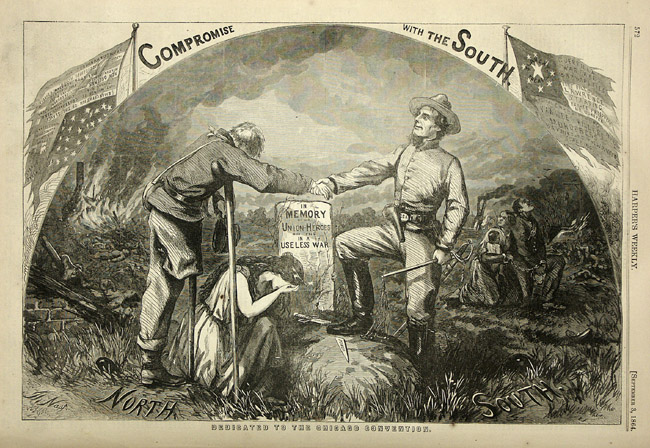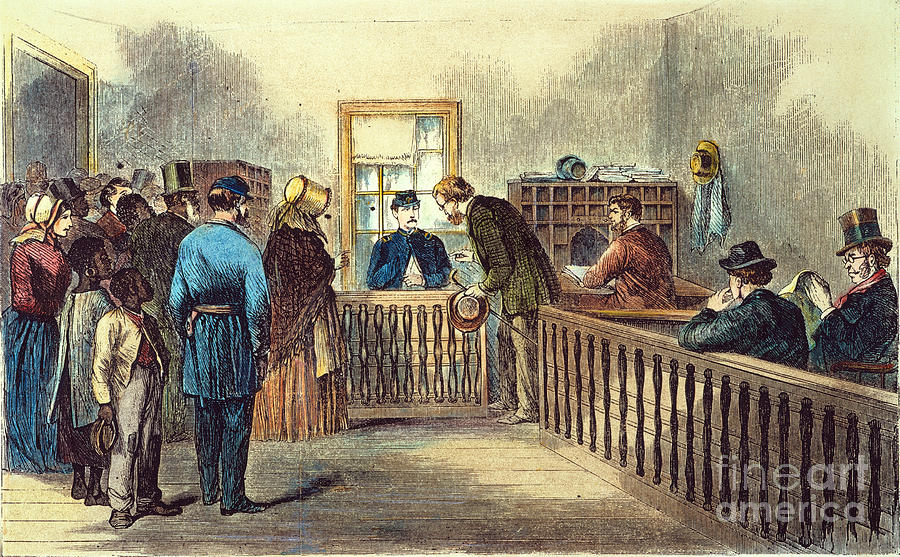
As reviewed in the New York Times Sunday Book Review, "A Less Perfect Union," by Sean Wilentz, on 10 September 2006 -- Ten years after Appomattox, Northern support for the newly enfranchised ex-slaves and their white allies had faded. Recalcitrant Southern whites, whose Ku Klux Klan night-riding had been aggressively repressed by the federal government in the early 1870’s, regrouped under the political aegis of the Democratic Party. By mid-decade, most of the Reconstruction state governments had fallen at the ballot box to the forces of white supremacy, the self-proclaimed “redeemers.”

An 1866 engraving depicts an agent of the Freedmen’s Bureau making peace between blacks and whites.
Mississippi, with a large black voting majority, resisted longer than other states, but redemption finally came there too, in 1875, sealed by a new frenzy of paramilitary carnage and intimidation. Two years later, after a disputed national election, the Republican Rutherford B. Hayes finally won the White House by agreeing to remove from the South the last of the federal troops who had upheld Reconstruction at the points of their bayonets. The troubled effort to build a Southern interracial democracy out of the ashes of the Civil War was over.
The story of Reconstruction’s demise in Mississippi is familiar to historians, and Nicholas Lemann, in “Redemption,” retells it in all its terrible gore. His account squares with recent scholarship, which has challenged both the traditional “Birth of a Nation” view (of Reconstruction as a tragic era of black plunder and white degradation) and the skeptical scholarship of the 1960’s and after that questioned the reformers’ commitment. Lemann, the dean of the School of Journalism at Columbia and the author of “The Promised Land,” among other books, affirms Reconstruction as a noble, thwarted experiment, the nation’s “unfinished revolution,” in the words of the era’s current leading historian, Eric Foner. This book strives to burn that academic re-evaluation into the minds of nonacademic readers.

REDEMPTION: The Last Battle of the Civil War; By Nicholas Lemann
Written on a dramatic human scale, and leavened by some fresh research and analysis, it is an arresting piece of popular history. Lemann is a responsible writer who aims to convey what he calls “the feeling of history unfolding, not of history considered in retrospect.” But “Redemption” inevitably speaks to the present as well as about the past. In focusing on Reconstruction Mississippi, Lemann, a native of New Orleans, stirs living memories of the murderous Southern resistance to the civil rights movement 90 years later. And he writes at a time when neo-Confederate sympathies have cropped up again in Southern politics, amid reports about the suppression of minority voting throughout the country. We are still living with the consequences of what Lemann presents as the “last battle of the Civil War.”
The book opens not in Mississippi but with an extended prologue about the notorious 1873 massacre in Colfax, La., the bloodiest episode of racial violence during the Reconstruction era. The Colfax events — in which more than 70 mostly black militiamen were killed by white supremacists after a disputed election — sparked immediate Northern outrage but led three years later to the landmark Supreme Court ruling United States v. Cruikshank, which upheld states’ rights against federal authority to protect the freedmen from white terrorists.

These changing circumstances made the situation almost impossible for Lemann’s chief protagonist, Mississippi’s Reconstruction governor, Adelbert Ames. Ames was a paragon of Yankee gallantry who blended ambition and idealism, Lemann writes, “almost to the point of aspiring to sainthood.” The son of a sea captain from Rockland, Me., he had graduated from West Point just in time to fight courageously in numerous major Civil War battles, for which he received the Medal of Honor. In 1868, Ames was appointed provisional military governor of conquered Mississippi. Deeply moved by the plight of local blacks, he cast his lot with the state’s fledgling Republican Party. Elected by the Reconstruction legislature to the United States Senate in 1870, he ran for governor three years later on a biracial Republican slate and, with enthusiastic support from ex-slaves, easily defeated his more conservative rival. Although disparaged as a “carpetbagger” by anti-Reconstruction whites, Ames took pride in his conviction that, as he later wrote, he “had a Mission with a large M.” The new governor called for ambitious reforms, including the creation of a credible public school system, hoping to benefit all the state’s citizens while lifting the freedmen out of their abject poverty and illiteracy.
Lemann presents Ames’s political rise in counterpoint with his courtship of Blanche Butler of Massachusetts, whom he married in 1870. Their loving correspondence reveals to Lemann “a subtle dynamic of mutual adjustment.” But the Ameses’ marriage also had important political implications. Blanche’s father was the Radical Republican congressman Benjamin F. Butler, whose intransigent command of the Union Army occupation of New Orleans caused white Southerners to nickname him “Beast” Butler, and who now stood, Lemann writes, “at the very top of the South’s pantheon of resentment.” By the early 1870’s, Butler was a confidant of President Grant and one of his staunchest supporters on Capitol Hill, especially when it came to crushing Southern white resistance to Reconstruction. As Beast Butler’s son-in-law, Ames had a line to the highest levels of the federal government — and appeared all the more evil to Mississippi’s reorganizing white supremacists.

The counterrevolution began in Vicksburg during the summer of 1874. In anticipation of local elections, a group of whites infiltrated a Negro Republican Fourth of July celebration and began shooting, which touched off an anti-black rampage. At the end of the month, Ames sent Grant a long telegram, pleading for federal military intervention, but Grant, relying on an inconclusive report from his secretary of war, William W. Belknap, refused. In August, the Democrats swept the Vicksburg municipal elections, although Republican blacks, including Sheriff Peter Crosby, a Union Army veteran, still held key countywide positions. Only in September, after receiving horrifying letters from ordinary citizens, did Grant authorize sending troops wherever local officials were losing control.
Emboldened by the election returns, Mississippi’s white supremacists organized their own paramilitary group, the White Line. In Vicksburg, they forced the resignation of Sheriff Crosby, who countered by forming a temporary black militia, and the two sides squared off in armed battles. Ames once again alerted the president, who dispatched Gen. Philip Sheridan to restore order to the entire Gulf region.

Sheridan’s troops, as part of their general operations, returned Crosby to his elected office; and Sheridan sent a fierce telegram to Secretary Belknap, calling the white resisters “terrorists” and “banditti,” and bidding the president to denounce them as such. But Sheridan’s message struck most Northern Republicans as excessive, and now exhausted by the endless violence, they publicly deplored renewed federal intervention. Grant issued a proclamation strongly defending Sheridan, but the document hedged on the question of the limits of federal power. Reconstruction’s opponents, Lemann writes, “would not have been wrong in detecting a wobble” in the administration’s position.
The wobbling worsened over the following year. White Line violence against Republican gatherings and individual black political leaders reached a fever pitch. Efforts by stalwart pro-Reconstruction Republicans in Congress to pass tougher enforcement legislation failed, partly because of the machinations of a shrewd and articulate Mississippi Democrat, Congressman Lucius Quintus Cincinnatus Lamar. Grant’s recently appointed attorney general, the conservative Edwards Pierrepont, deftly muffled the president’s impulses to send additional military support.

The embittered Ames decided to reorganize, augment and activate Mississippi’s mostly black militia, and thereby forced a peace conference with the Democrats. In exchange for Ames’s order to send the militia home, the Democrats agreed to respect black voting rights in the fall elections. But the paramilitary White Liners would not be denied. After a brief pause, they resumed their intimidation, which culminated in a massive show of force on Election Day. Democrats did not hide their approval. In some heavily black districts, Republican totals dwindled almost to zero, and the Democrats took control of the state legislature. In January, the newly elected lawmakers assembled in Jackson, listened to Ames denounce the violence and, a few weeks later, geared up to impeach him.
At the end of March, Ames agreed to resign in exchange for the charges’ being dropped, and left Mississippi. A Senate select committee investigated over the summer and issued a damning report on the White Line outrages. But by then, a fresh round of terror and intimidation had begun around the presidential campaign that would ultimately end all of Reconstruction.

Lemann’s interpretation of the politics behind these events is uneven. By depicting Reconstruction as the final phase of the Civil War, he suggests that the Confederates actually won, which diminishes the epochal importance of emancipation and secession’s defeat. Lemann does write astutely about the white supremacists and their coordinated multi-track political strategy, whereby respectable conservative Democrats like Lamar kept to the high road (and attacked the Republicans as profligate tax-and-spenders) while leaving the dirty work to the White Line. But the black participants in the story remain mostly obscure, and often come across more as victims than as political actors militantly defending their rights. Lemann also slights the political shrewdness of local black politicians (who had engineered Ames’s run for the governorship in the first place), while failing to convey fully the governor’s political naïveté in dealing with his opponents.
Lemann shows far less indulgence toward Grant, who appears mainly as a confused, politically expedient sellout. In fact, the president, whose father had been strongly antislavery and who had crushed the Klan in 1871, risked considerable political capital on behalf of the ex-slaves. His stance concerning Reconstruction became politically untenable after 1874, when he faced opposition from the Supreme Court, a newly elected Democratic House and even his own cabinet — yet Grant still did the best he could more often than not. Lemann considers the extenuating circumstances but also describes Grant as, by turns, dour, cryptic, callous and malignly opportunistic — thus making it difficult to comprehend why his friend Frederick Douglass said that “in the matter of the protection of the freedman from violence his moral courage surpassed that of his party.”

Lemann’s accounts of the racial mayhem in Mississippi in some ways contradict his pitting of Ames the idealist against Grant the pol. Given the vicious hostility among Southern whites to Reconstruction, success would have required far more patience and willpower than the North possessed, and many more resources than the pro-Reconstruction Southerners could muster on their own, even in states with largely black populations. Numerous factors outside Grant’s direct control — including a devastating national economic panic in 1873; Republican bribery scandals; and the convulsive electoral realignment in 1874, which produced the Democratic House majority — tragically made matters even worse for the ex-slaves and their radical allies.
In reaching for the attention of general readers with a brief, highly concentrated narrative, “Redemption” simplifies too much. But it offers a vigorous, necessary reminder of how racist reaction bred an American terrorism that suppressed black political activity and crushed Reconstruction in the South. And it illuminates the often bloody fights over black voting rights that would recur for a century to come — and remain, even today, a source of partisan strife, albeit without paramilitary gunfire and with the party labels reversed. (source: The New York Times)
No comments:
Post a Comment